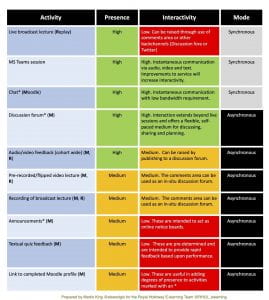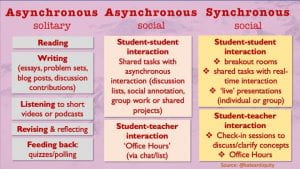Kate Cooper (Professor of History, Royal Holloway, University of London)
One of the problems worrying wise heads as they think ahead to the autumn involves the instructional quantum formerly known as contact hours. Once we are no longer meeting in timetabled classrooms, how will we know when we have done enough? It’s a question that has a philosophical dimension, but it’s also tremendously practical. On the one hand, digital teaching requires thinking ahead to solve as many problems as possible ahead of time. On the other hand, students navigating in an unfamiliar digital environment might reasonably need more support than ever.
In a piece entitled The need for Presence not ‘Contact Hours’, David White, who is Head of Digital Learning for the University of the Arts London, addresses the problem head-on. Part of the problem, White suggests, is that our way of thinking about what we owe our students has been rooted in a not-particularly-well-thought-through emotion: the attachment we all feel to ‘the University as a set of buildings.’ Partly out of habit and partly because emotional attachment makes us irrational, he says, ‘The narrow definition of Contact Hours in the UK basically boils down to “time spent in the same room together”.’ This means we have failed to think as carefully as we might about what our students need from their interactions with teachers, and the resulting muddled thinking can have spectacularly bad results.
So in the move to online teaching our initial instinct is to preserve Contact Hours by mirroring what would have been face-to-face sessions with webinar style sessions. What this looks like [in some contexts] is exhausting 3-4 hour online sessions which must be almost impossible to stay engaged with. Not only is this unsustainable, it is also damaging to the learning process.
Another useful approach comes from Colorado, where Sean Michael Morris is Senior Instructor in Learning, Design, and Technology at the University of Colorado Denver and Director of the online learning community known as Digital Pedagogy Lab. In a recent post Morris suggests that the answer to the problem rests on an idea we can all agree on: the best pedagogy is rooted in human relationships. “My expertise is digital pedagogy—specifically critical digital pedagogy—which resides more in the relationships between teachers and students than it does the delivery of instruction.” In facing up to the digital challenge, he says, colleagues can become so worried about managing the technology that they need to be reminded of the human element.
So as I’m approached with questions about what technologies might help build community online, what platform I might recommend for ensuring students don’t cheat, or what digital solution I know of that will enable meaningful discussion, I’ve found myself answering: teach through the screen, not to the screen. Find out where your students are, and make your classroom there, in a multiplicity of places.
How we make this happen, of course, is the question. What does it mean to be ‘present’ in a space that doesn’t actually exist?
Another important aspect of the problem involves not only space, but time. To what extent is a ‘scheduled hour’ a meaningful measure? Far less than we are used to, perhaps: to students (and staff) who are living in a state of perpetual disruption, freedom from set schedules can offer a much-valued silver lining, and is sometimes an absolute necessity.
My colleague Martin King at Royal Holloway makes an important distinction here. Even though being ‘present’ to our students is something that we are used to doing in real-time, sometimes the acts of ‘presence’ we can offer asynchronously are just as valuable. To illustrate the point, Martin kindly gave me permission to share a graphic analysis he made of the possibilities for ‘presence’ that can be offered to students through the Moodle/Replay learning tools we use in our own institution.
Martin places strong emphasis on something that is sometimes forgotten in discussions of ‘contact’, which is interactivity. Sometimes, when we are sailing along in our habitual way of teaching and learning together, we forget that what makes contact ‘contact’ is the fact of being able to interact. Often, interaction is the element that lights up the learning experience for students.

(https://elearningroyalholloway.blog/2020/05/07/considerations-for-online-teaching-pt-1-presence/)
Once we’ve turned our focus to interactivity, we can see that though we’re used to thinking of synchronous activity as conveying a strong sense of presence, when interactivity is present asynchronous activity can do so as well. And colleagues are already reporting that new forms of engagement such as discussion lists can elicit higher involvement from students who would hesitate to contribute in face-to-face discussion.
Another point to remember is that sometimes the ‘presence’ our students find most valuable and rewarding is that of their peers. Taking Martin’s analysis as a starting point, I made my own visual analysis, this time looking at how the social and interactive aspect of learning can work both synchronously and asynchronously, sometimes through engagement between students and staff, and at other times through engagement among students themselves. (The ‘asynchronous-social’ column in the centre offers particularly useful food for thought.)
How can we translate these insights into strategies for supporting students? David White suggests that if we move our thinking away from counting contact hours to planning for meaningful acts of presence, we may discover that the new landscape offers surprising possibilities.
Here is the list White offers at the close of his post:
- A fairly quick, reliable, turnaround to emailed questions
- Being active ‘live’ in forums or text chats (an ‘office hours’ approach to asynchronous presence)
- Lively synchronous sessions – such as, webinars with plenty of Q&A
- Artfully ‘flipped’ use of pre-recorded teaching videos
- Audio, video or text summative feedback (if it’s been created just for you then it’s always a moment of presence)
- …and of course face-to-face sessions in various forms.
It’s not hard to imagine a student being happy with this approach to presence. It’s perhaps an idealized list – notice all those adjectives and adverbs. (‘Reliable’, ‘lively’, ‘artfully’.) So, the proof will be in the design (how do they all fit together? do they add up to more than the sum of the parts?) and in the delivery. But that is true for every type of teaching, so at least here we are on familiar territory.
Research conducted by the Higher Education Policy Institute (HEPI) and Higher Education Academy (HEA) via the 2015 Student Academic Experience Survey discovered a greater correlation of student success to increased independent study than to increased contact hours, and increased independent study also correlated to a higher student sense of engagement. Commenting on the survey, Professor Stephanie Marshall, then serving as CEO of the HEA, had this to say:
“It’s important to note the relatively high numbers who do not feel supported in independent study … we know that the skills developed through independent study are important to employers and to lifelong learning. Providing guidance and structure outside timetabled sessions is key here.”
So there is potentially much to be gained from shifting our focus from measuring staff input to considering how best to offer our students what they need.
For department chairs and administrators, there remains a thorny administrative problem: it’s far more difficult to assess whether a multi-strand ‘presence’ strategy has been executed successfully than it is to count timetabled contact hours. But from the student perspective, if the present disruption forces us to focus on the fundamentals, this can only be a good thing.
Kate tweets as @kateantiquity
Here’s Kate’s webpage at RHUL

You must be logged in to post a comment.